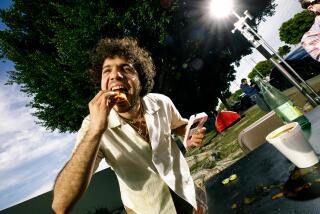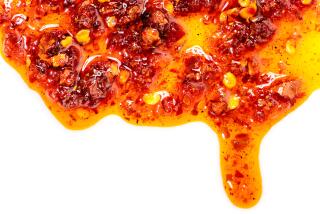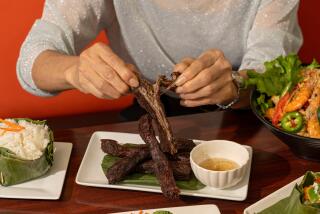Sriracha hot sauce purveyor turns up the heat
The gig: David Tran, 68, founded hot sauce company Huy Fong Foods Inc. in Chinatown in 1980 and a few years later introduced Sriracha sauce to the U.S.
His Sriracha, a version of a hot sauce originating in Si Racha, Thailand, quickly spread through the San Gabriel Valley and eventually the nation. The fiery red concoction in the clear bottle with the distinctive green cap and rooster logo has since gone mainstream: Google “Sriracha” and you’ll find such things as cookbooks, water bottles, iPhone cases and T-shirts.
Huy Fong Foods, which is still privately owned, sold more than $60 million worth of sauce last year, office manager Donna Lam said.
Refugee: When North Vietnam’s communists took power in South Vietnam, Tran, a major in the South Vietnamese army, fled with his family to the U.S. After settling in Los Angeles, Tran couldn’t find a job — or a hot sauce to his liking.
So he made his own by hand in a bucket, bottled it and drove it to customers in a van. He named his company Huy Fong Foods after the Taiwanese freighter that carried him out of Vietnam.
Packing heat: Early on, one of Tran’s packaging suppliers told him, “Your product is too spicy. How can you sell it?” Add a tomato base, some friends counseled. Sweeten the flavor to pair it better with chicken, others said. But Tran stood firm.
“Hot sauce must be hot. If you don’t like it hot, use less,” he said. “We don’t make mayonnaise here.”
Pricing it right: Tran had just one guiding business principle: “Make a rich man’s sauce at a poor man’s price.” In more than two decades of operation, Tran has kept the wholesale price of his sauce constant, but he would not disclose it. A 28-ounce bottle goes for about $4, depending on the retailer.
“My American dream was never to become a billionaire,” Tran said. “We started this because we like fresh, spicy chili sauce.”
That means cranking up the chili content of each bottle and making sure each pepper is as hot as possible, Tran said. As the company grew, Huy Fong Foods developed a relationship with a supplier in Ventura County and carefully monitored the entire growing process from seed to harvest.
Now, each chili is processed within a day of harvesting to ensure peak spiciness.
Production strained: In 2007, the company oversold its sauces and ran out of the peppers with three months left in the year. Stores marked up their prices and many started to hoard the sauce, Lam said.
Under immense pressure from customers, Tran considered his possibilities. He could buy supermarket jalapenos, but that left no way to predict the heat of the sauce. Brined peppers were also out of the question — who knew how those had been grown?
So, Huy Fong Foods went to each of its customers and asked them to wait — and they did. “We didn’t lose any customers,” Lam said.
Now the company sets a monthly production quota for each sauce. Every bottle of sauce produced already has been sold, Lam said.
Competition: The popularity of Huy Fong Foods’ Sriracha sauce has spurred many copycats and competitors. Because the sauce is named for the Thai city, the company cannot trademark the name.
Roland Foods in New York makes its own variety, Sriracha Chili Sauce, in a similarly shaped yellow-capped bottle featuring two dragons instead of a rooster. Frito-Lay is testing a Sriracha-flavored potato chip, and Subway is experimenting with a creamy Sriracha sauce for sandwiches.
But Tran said he’s not bothered by the fact that others are trying to capitalize on the market his sauce created.
“We just do our own thing and try to keep the price low,” Tran said.
Revenue grows about 20% a year even with all the competition. Huy Fong Foods has never spent a dollar on advertising.
Family business: Tran has no interest in branching out beyond making Sriracha and two other hot sauces, Chili Garlic and Sambal Oelek. All the Sriracha-branded products online are made by others. He spends hours Googling “Sriracha” and chuckling over fans’ creations.
He’s turned down multiple lucrative offers to sell his company, fearing his vision would be compromised.
“This company, she is like a loved one to me, like family. Why would I share my loved one with someone else?” Tran said.
He intends to keep it a family business: His son is the president, and his daughter is vice president.
He has repeatedly rejected pleas to sell stock in the company and turned down financiers who offer him money to increase production significantly.
“If our product is still welcomed by the customer, then we will keep growing,” Tran said.
New quarters: Huy Fong Foods has operated out of two buildings in Rosemead since the late 1980s, but it’s moving to a $40-million, 655,000-square-foot factory and headquarters in Irwindale that could triple its production capacity. The company expects to complete the transition by June.
“Who knows where the company will go? We just always try to make the best sauce possible,” Tran said.
Getting personal: Tran and his wife, Ada, live in Arcadia. They have two children.







